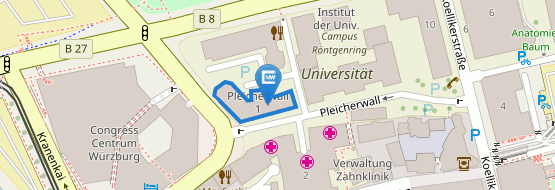Donation: Sounds wearing colors
06/28/2012There are two aspects making psychologist Georg Ernst Anschütz quite unique: first of all, he dealt with the early phenomena of synaesthesia; secondly, there is his highly controversial association with the Nazi regime. The Adolf-Würth-Centre for the history of Psychology received a gift that may help to understand Anschütz' life and work a lot better.
There are two aspects that make psychologist Georg Ernst Anschütz quite unique: first of all, he dealt with the early phenomena of synaesthesia; secondly, there is his highly controversial association with the Nazi regime. The Adolf-Würth-Center for the history of Psychology received a gift that may help to understand Anschütz' life and work a lot better. Tone colour, dark vowels, a shriek: within our every-day language, the phenoma of synaesthesia is well-rooted, though only recognised by the minority of us. Synaesthesia means: an individuum's reaction to a sensory stimulus can cause two or several different sensations. One may not only recognise the sounds of music, but also see its shapes and colours. There are other synaesthetes who connect sounds to various smells or flavours. One of the first German scientists to ever discuss this phenoma was psychologist Georg Ernst Anschütz. Until now, his property belonged to Shabo Talay, professor for Semitic Philology and Arabic Studies at the University of Bergen. Professor Talay now donated his documents to the Adolf-Würth-Centre for the History of Psychology at University of Wuerzburg. "It includes literature published by him: notes, letters, pictures, newspaper clips, souvenirs, gifts. To make it short: Anything that one collects during their life as researchers", says Armin Stock, director of the Center, about the donation. About 28 moving boxes are packed with Anschütz' estate and give an insight into his life and work. Especially his personal life has left a room for many questions.
Georg Anschütz' life career
Georg Ernst Anschütz was born on November 15th, 1886 in Braunschweig. From 1905 to 1912 he studied Music, Philosophy and Psychology in Munich, Leipzig, Bonn and Paris - and, during the summer semester of 1905, he was also enrolled at the University of Wuerzburg. Moreover, he did his doctorate at the University of Munich the very same year. After studying in Munich and Leipzig, Anschütz became a scientific assistant at the University of Hamburg from 1913 till 1915. On October 1st, he took the chair appointed to him within the Department of Psychology at the University of Constantinople, where he stayed until the end of World War I. Starting in January 1919, Anschütz was an employee at the University of Hamburg. He habilitated in 1920 and was professor for Psychology, Music Psychology and Music Aesthetics until his dismissal in 1945.
No career setback during Nazi Germany
It seems as if there are no indications of a conflict between Anschütz and the Nazi regime. After the former director of the Department for Psychology, William Stern, had been removed from his office in April 1933, Anschütz started to take on Stern's tasks, but never his post. In 1933, Anschütz joined the NSDAP, signing the commitment of all German professors and universities to Adolf Hitler and the Nazi regime. From 1939 to 1945, Anschütz was head of the lecturer body, the chief of the Dozentenbund at the University of Hamburg and leader of the Gaudozentenbund. After the end of World War II, Anschütz was kept in captivity for about one year. He never was offered a job at a German university thereafter. Instead, he ran the "Freie Forschungsgesellschaft für Psychologie and Grenzgebiete des Wissen" in Hamburg until his death on December 25th, 1953. Armin Stock describes Georg Anschütz as "a researcher who did not find the right path for himself during this politically difficult time." He also does not want to form a final opionion of Anschütz' role during the Third Reich. "In situations like this, you can never really tell whether this person did wrong, or prevented worse from happening", he says. However, he hopes that the estate may bring some light into the darkness of that time. But there is more to it than that. The estate also proves some scientific relevance: "Georg Anschütz worked on various projects dealing with many different topics", Stock explains. His interests ranged from the early beginnings of Gestaltpsychology to the research of intelligence and even to questions concering music and its aesthetics. In the late 1920s and 1930s, he focused on researching synaesthetics, i.e. coloured hearing, and published his results in three volumes. According to Stock, "those papers may still be relevant within the field of neuro-psychology, for example in the context of Autism, since the number of autistic people who are also synaesthetes is quite high."
The estate and its journey to Wuerzburg
As Shabo Talay mentioned at the ceremonial signing of the deed of donation, it was a real coinicidence he ended up with the estate. The expert for Arabic and aramaic accents in Syria had met Anschütz daughter, the ethnologist Helga Anschütz, who had engaged herself in researching the Christian minorities in the Middle East, at work. After her death he was informed that she had appointed him the heir of her father’s estate, linked with the task to make it open to the public. Since Talay’s enquiries to the Universities of Hamburg and Istanbul received no responses, the 28 moving boxes ended up at the Würth-Center. „This was just the right place for them", Talay said. After all, there is a wide range of other Psychologists’ estates deposited in the archives, allowing for quite a good comparison. Moreover, the material will be available for science. Dr. Uwe Klug, chancellor of the University of Wuerzburg, thanked Talay for the donation, assuring him that the Adolf-Würth-Centre is going to develop the estate and make it open to research and the public.
(Gunnar Bartsch)


